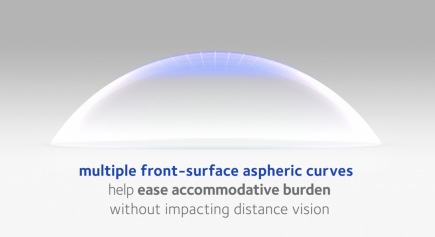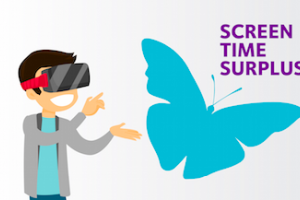Extended periods using digital devices (computers, smartphones, tablets, etc.) are associated with ocular symptoms and physical discomfort.1-3 As many as 90% of digital device users experience symptoms of digital device use or asthenopia.1 CooperVision is proud to bring this technology to both your 1-day and monthly wearers with MyDay Energys® and Biofinity Energys®.
Read on to learn more about how this lens design helps.
A recipe for asthenopia at any age
A consequence of extended device use is accommodative micro-fluctuations (AMFs) that occur at near viewing. AMF is the temporal ocular instability caused by spasms of the ciliary muscle when viewing a near target.4
There are two components to AMF4:
- Low frequency of less than 0.6Hz that is of neurological origin
- High frequency of 1.0-2.3Hz that is related to arterial pulse frequency
Overworked, tired ciliary muscles are not responsive to slight increases in accommodative load, causing the high-frequency component of AMF to rise.4
In addition, physical changes to the ciliary muscle are observed during the accommodation process. The ciliary muscle exhibits an increase in anterior length thickness and maximum thickness. During accommodation on a near image at 20 cm, ciliary muscle anterior length thickness increased 23%, and maximum thickness increased 34%.5
The stress caused by the accommodative response, along with a dry, irritated ocular surface, is a recipe for asthenopia (eye fatigue and eye strain).
A study to compare contact lens designs6**
A paper presented at BCLA 2021 sought to determine if wearing spherical or aspherical lens designs impacted AMF and patient-reported symptoms of eye fatigue or strain related to digital device use. This prospective, cross-over, subject-masked evaluation included 24 individuals aged 20 to 35 who used digital devices for four or more hours per day and currently wore soft contact lenses with sphere range +3.00 to -6.00DS; <0.75DC. This was a cross-over study where participants were assigned to two equal groups, then fitted with either Biofinity or Biofinity Energys for two weeks, followed by a switch to the other lens for two weeks. Evaluations included baseline measures of accommodative functions, the performance of both contact lenses on the last day of wear, and patient-reported changes in symptoms of digital device use.
Contact lenses compared had the same material, water content, diameter, and base curve. The only difference between lenses was the front-surface optical design. DigitalBoost™ technology has multiple aspheric curves, which introduce greater positive power at the center of the curve, providing a +0.3D boost for device viewing. In contrast, Biofinity Sphere is aspherical, which reduces the spherical aberration introduced by the lens power.
Aspherical lens design can improve AMF response6*
Findings from the study showed that subjects wearing DigitalBoost™ technology (Biofinity Energys) experienced significantly lowered AMF compared to a spherical lens (Biofinity Sphere). The study also showed that visual acuity levels are very good with DigitalBoost™ technology, and there was no significant difference in acuity in those fitted with sphere.

Aspherical lens design reduces patient-reported eye tiredness6*
At the end of every two weeks of contact lens wear, investigators administered the Italian version of the standardized Computer-Vision Symptom Scale questionnaire (CVSS17) to evaluate changes in self-reported symptoms.
In this study, DigitalBoost™ technology wearers were significantly less likely than sphere wearers to say:
- Their eyes felt tired during or after working with a computer
- They had to strain to see well after some time working with a computer
- Their eyes hurt when working with a computer
- They had to blink a lot while using the computer at work
- They had heavy eyes at the end of a working day
Conclusions
- When all other features are identical, DigitalBoost™ technology reduces accommodative microfluctuations compared to a spherical lens
- Several patient-reported symptoms of digital device use significantly improved with DigitalBoost™ technology
- Contact lenses with DigitalBoost™ technology help reduce subjective symptoms of digital device use in young adults*
Visit the MyDay Energys® and Biofinity Energys® product pages to learn more.








